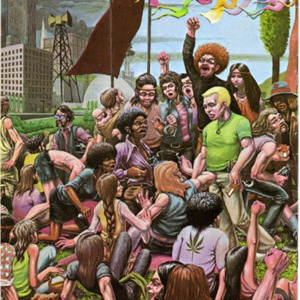Back Cover of "Radical Rock" (1972)
Dublin Core
Title
Description
In his essay “Icons of the Alternate Culture,“ Thomas Sanders writes that “a significant amount of comix material is devoted to an exploration of the artistic potential of the medium” (846). This image is an example of that exploration. In the cover to “Radical Rock” (1972), the second issue of Inner City Romance Comix, writer and illustrator Guy Colwell plays with classical painting and the medium of comix. In the preface to an Inner City Romance collection, Colwell is quoted saying, “There are also deeper, older artistic influences that perhaps ( …) inform my comic book work. Very strong inspiration comes from Renaissance painting, especially Northern Renaissance” (Rosenkranz xv). This Renaissance influence is very clear in this cover art through the busy and chaotic staging, as well as the rich use of color. Both pull from a Northern Renaissance style that complements and complicates the debauchery depicted.
This cover portrays the audience of a large music festival concert, and though it is a rather flat image in regards to perspectival lines, the use of overlap and deep staging constructs multiple focal points. A viewer’s gaze can be drawn to the hubbub in the front left, where it seems a plainclothes policeman (the blonde man) reveals his identification and seizes the arm of a man in a large group of concert-goers smoking marijuana, much to the consternation of the group. Or the viewer’s gaze can travel to the middle-ground right, where a black man boogies with a white woman. A viewer might then look slightly to the left in the background and see a group of white women and one white man dance naked and free.
True to the style of the Northern Renaissance, no event is isolated or rendered more significant than others. Neither are any figures elevated in import or visual value above the rest at large. The visibility of race in this image forms interesting meanings when considered in this stylistic context. Beyond the color of their skin, there’s a tendency of the black figures to have tight, curly hair, and for the white figures to have long, flowing hair. However, this is not observed as a rule. There is a red-headed white man with a big curly afro. There is a black man just to his left with shining smooth hair. Facially and bodily, all figures are depicted fairly equally, contoured to pop out from what’s behind them and caricatured somewhat beyond realistic depiction. The people are equally emotive and equally personified. In contrast to Colwell’s work within book, as seen in the images in “Choices,” where black figures are distinctly racialized differently from white figures, this visual egalitarianism seems significant.
Typical of comic book cover art, the Renaissance style of this cover assumes the status of higher, more quality art compared to the cartoon style within the book. It perhaps aims to be read as a truer representation, one that breaks down barriers not through de-racialization but through reduced differentiation; not ignoring race but disempowering it. If so, this cover art “present[s] healthy alternative values, perceptions and artistic techniques under the guise of smut, art and entertainment” and captures the meanings and intents of “Radical Rock,” Inner City Romance, and much of racially progressive underground comix as a whole (Sanders 848).
Rosenkranz, Patrick. Preface. Inner City Romance. By Guy Colwell. Fantagraphics, 2015. vii – xv. Print.
Sanders, Clinton R. "Icons of the Alternate Culture: The Themes and Functions of Underground Comix*." The Journal of Popular Culture 8.4 (1975): 836-852. doi: 10.1111/j.0022-3840.1975.00836.x

